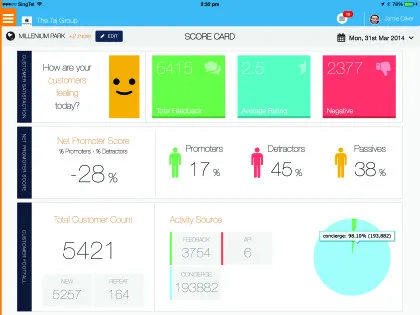
IT in Retail: IT eases marketing and growth
The experiences of two Australian companies show how small and medium-sized retailers can harness technology to break into international markets. Richard Seah finds that how retailers are empowered by IT.
Retailers cannot complain that there is insufficient technology to help them with the business. Ever more powerful computing and information technology systems are not only providing businesses with more and more data – but also offering the information in a simpler way that can be easily accessed and assessed.
It means, for example, that retailers can get detailed profiles of their different customers and their consumption patterns – what do they buy most often, when and how. For instance, a pizza restaurant can have a good idea of which customer is more likely to order a particular pizza flavour, for dine in, take away or delivery. The restaurant can get other insights, such as who is more likely to order at the restaurant or via telephone, website, Facebook and other channels.
Such information can now be easily accessed by management and marketing staff, without having to wait for IT professionals to churn out reports. The information can be used for very specific marketing campaigns and advertising messages aimed at specific customer segments. For example, customers who have a habit of ordering delivery pizza late at night might be informed about late night special offers. One who likes seafood pizza would be informed about seafood specials. And so on.
By enabling highly targeted and personalised messages, today’s retail specific IT solutions enable the retail marketer to implement much more effective marketing programmes.
Information gathering is made easy as well. Factual data such as purchase details can be automatically collated in most cases with the rise of electronic payments. Subjective data, such as a customer’s satisfaction level, complaints or compliments, can be easily filled in by service staff or even customers themselves who may be presented with an iPAD application at the store or encouraged to give feedback on the social media sites.
Yet there is opportunity to mine even more information. At the World Retail Congress Asia Pacific held in Singapore in March, technologies on show included “store mapping”, which could indicate the number of people at different sections of a department store. This would not only reveal which sections are more popular, it could also improve service levels by alerting the store operator to send more staff to the crowded areas – or even to increase the air conditioning there.
Other technologies track what products individual shoppers have been browsing and reinforces the purchase interest. A man who had been looking at jeans, for example, could be shown a jeans advertisement as he walks past an advertising panel. He wouldn’t be shown maternity wear. He might think it is a coincidence. But to a large extent such sales efforts can now be planned – and even automated.
These solutions are only now being marketed so it might be a while before we see them widely implemented in the region. For now, we look at some IT solutions that have already been found useful.
Engaging customers
In the food and beverage industry, more than 100 establishments in Singapore have started to use mEngage, a customer engagement IT solution officially launched by Mobikon Asia at the recent Food & Hotel Asia exhibition. mEngage is a platform that provides, at one glance, a spectrum of customer information that includes their buying habits as well as satisfaction levels.
“The mEngage platform provides a single dashboard that integrates existing systems and apps to provide customer data and analytics. The platform can also integrate point-of-sale systems, third party apps and social networks to be viewed as a single mEngage dashboard,” explains Samir Khadepaun, founder and CEO of Mobikon Asia.
“Restaurants, cafes and eateries can focus on delivering delicious meals and good service experiences while automating customer and marketing support functions.
“The platform helps food establishments understand what their customers think about them and also get deeper insights on parameters such as food quality, location, ambience, preferences, etc. They can receive and view real time customer feedback, respond immediately via email or SMS and create on-the-go promotions targeting their customers.”
Samir estimates that restaurants can save over S$3,000 in manpower expenses a month by automating the customer community management and marketing functions.
Users of the mEngage system in Singapore include Twelve Cupcakes, Soup Restaurant and Swensen’s. Mobikon also has users in Dubai and India, with a total of 95 food & beverage brands operating over 500 outlets.
Establishing presence in e-marketplaces
Online, an IT solution from ChannelAdvisor has helped several small companies in the region establish a significance presence in large international marketplaces like eBay, Amazon and Rakuten.
This is a solution that automates day-to-day tasks for online retailers such as order fulfillment, juggling quantity and updating the product catalogue. It further analyses sales performance at a general level as well as for specific products. In addition, ChannelAdvisor also synchronises a company’s marketplace presence with its own web store.
One user of ChannelAdvisor is Box13, an Australian-owned online retailer specialising in urban street wear, sports apparel and hardware for skateboarding, snowboarding and surfing. Established in 2011, Box13 initially sold through its own web store, but soon saw the limitations. It decided in 2012 to also sell via eBay, Amazon and Trade Me, a New Zealand-based marketplace.
Says founder and director Simon Bruce: “We felt that we couldn’t realise our full potential by solely selling through our own online site. We enlisted the services of ChannelAdvisor and experienced instant success.”
Bruce shared that going onto eBay resulted in an almost overnight 30% increase in sales for Box13. Trade Me added a further 15% and sales to New Zealand now accounts for a quarter of Box13’s total sales.
“Operating from a single platform ensures that we have a consistent approach across our marketplace channels while minimising administrative effort,” says Simon. “It has also significantly simplified the training needs of our employees. By mastering the ChannelAdvisor platform, they’re able to deliver quality customer service across each marketplace in a reliable fashion.”
Another successful user is RetailSplash, an Australian e-commerce company with three very different brands — Dungeon Crawl, which sells video games; ToolHQ, which sells power tools and appliances; and IndulgeHQ, which sells UGG boots (unisex sheepskin boots popular in Australia and New Zealand) and associated luxury items.
Each RetailSplash brand generates sales through its own dedicated website as well as third-party channels like eBay and Trade Me.
While Box13 went from its own website to international marketplaces, RetailSplash did the opposite. In 2011, it first enlisted ChannelAdvisor to transition Dungeon Crawl from an eBay-only sales model to having its own website. All three of RetailSplash’s sites were subsequently set up using ChannelAdvisor’s Webstores product, while inventory and order management are automated through the Marketplaces solution.
Says RetailSplash co-owner Neville Samuels: “ChannelAdvisor’s Marketplaces solution acts as a hub for order fulfilment and inventory, allowing us to integrate new channels into the mix without having to revamp or recreate back-end processes every time. It reduces the cost of expansion and maintains consistent service levels across a range of channels and brands.
“Last year, eBay asked us to run UGG boot sales for 18 or 19 Northern Hemisphere markets, which we were able to quickly incorporate as just another channel,” Samuels adds. “In an industry that moves as fast as online retail, you need robust and flexible technology to grasp opportunities ahead of your competition. ChannelAdvisor has given us confidence to do this.”
Retail Splash has grown to become one of Australia’s biggest online retailers. Says Samuels: “Many of the ambitions we had just two years ago have already been realised or exceeded.”
The possibilities of leveraging advanced information technology for business growth are many. With more businesses venturing into the realm of omnichannel retailing, information technology can be expected to play an even bigger role – in managing the business, marketing and improving the shopper experience.



















 Advertise
Advertise







